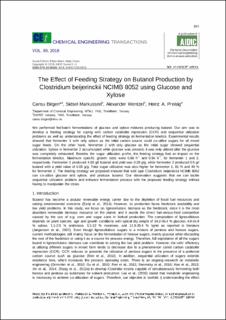| dc.contributor.author | Birgen, Cansu | |
| dc.contributor.author | Markussen, Sidsel | |
| dc.contributor.author | Wentzel, Alexander | |
| dc.contributor.author | Preisig, Heinz A. | |
| dc.date.accessioned | 2023-05-31T13:25:53Z | |
| dc.date.available | 2023-05-31T13:25:53Z | |
| dc.date.created | 2018-07-05T20:23:25Z | |
| dc.date.issued | 2018 | |
| dc.identifier.citation | Chemical Engineering Transactions. 2018, 65, 283-288. | en_US |
| dc.identifier.issn | 1974-9791 | |
| dc.identifier.uri | https://hdl.handle.net/11250/3069519 | |
| dc.description.abstract | We performed fed-batch fermentations of glucose and xylose mixtures producing butanol. Our aim was to develop a feeding strategy for coping with carbon catabolite repression (CCR) and sequential utilization problems as well as understanding the effect of feeding strategy on fermentation kinetics. Experimental results showed that fermenter 1 with only xylose as the initial carbon source could co-utilize sugars for all mixed sugar feeds. On the other hand, fermenter 2 with only glucose as the initial sugar showed sequential utilization. Xylose in fermenter 2 accumulated while glucose was present; it was only utilized after the glucose was completely exhausted. Besides the sugar utilization profile, the feeding strategy had an impact on the fermentation kinetics. Maximum specific growth rates were 0.68 h-1 and 0.94 h-1, for fermenter 1 and 2,respectively. Fermenter 1 produced 4.98 g/l butanol and yield was 0.28 g/g, while fermenter 2 produced 0.5 g/l butanol with a yield value of 0.05 g/g. Total sugar utilization was also higher for fermenter 1, 81 % and 46 % for fermenter 2. The feeding strategy we proposed showed that wild type Clostridium beijerinckii NCIMB 8052 can co-utilize glucose and xylose, and produce butanol. Our observation suggests that we can tackle sequential utilization problem and enhance fermentation process with the proposed feeding strategy without having to manipulate the strain. | en_US |
| dc.language.iso | eng | en_US |
| dc.publisher | AIDIC | en_US |
| dc.title | The Effect of Feeding Strategy on Butanol Production by Clostridium beijerinckii NCIMB 8052 Using Glucose and Xylose | en_US |
| dc.type | Peer reviewed | en_US |
| dc.type | Journal article | en_US |
| dc.description.version | publishedVersion | en_US |
| dc.source.pagenumber | 283-288 | en_US |
| dc.source.volume | 65 | en_US |
| dc.source.journal | Chemical Engineering Transactions | en_US |
| dc.identifier.doi | 10.3303/CET1865048 | |
| dc.identifier.cristin | 1596014 | |
| dc.relation.project | Norges forskningsråd: 257622 | en_US |
| dc.relation.project | Norges forskningsråd: 521732 | en_US |
| cristin.ispublished | true | |
| cristin.fulltext | original | |
| cristin.qualitycode | 1 | |
